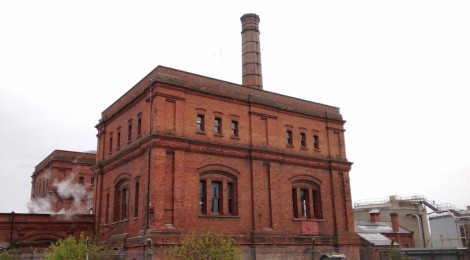
A Change of Scenery
On a trip to see family, over the bank holiday weekend, I took the opportunity to go and see the Clay Mills Pumping Station, in North Staffordshire.
The pumping station was built in 1885 to deal with the increasing sewage problem, created by the breweries of Burton on Trent. The huge amount of brewery effluent made the disposal of waste more problematical than in the average Victorian town.
The site is designated Grade II*. During the 1970s the pumps were decommissioned as the new, neighbouring station was commissioned. During the 1980 Severn Trent Water and English Heritage carried out some remedial work to ensure the stability and the fabric of the buildings. In 1993, the Claymills Pumping Engines Trust was founded and work commenced to bring the station back to life.
By 1998 one of the Lancashire boilers was again raising steam and 2000 ‘C’ engine made its first run.

Clay Mills along side the new Severn Trent plant
Like all Victorian pumping stations the buildings and engines are extremely impressive, with obvious care and attention having been lavished on design and construction. Once inside the station the first thing that hits you is the huge amount of engines in steam ( I counted at least 19 running!). The main pumping equipment is made up of four Woolf compound, beam pumping engines. The engines were built in 1885 by Gimson and Company of Leicester. The engines, with 24-inch bore and 6-foot stroke, are arranged in two pairs, in two separate engine houses, with a central boiler house. Currently two of the four engines are operational as work continues on the A & B engines.

The pistons and valves of ‘D’ engine in the cathedral like space

the impressive beams and gantry crane

Top of the 24 inch bore pistons

The Gimson and Company makers plate

The line up of Lancashire boilers complete with their Meldrum and Clayton Sprinkler Stokers
Apart from the pumping engines there is a plethora of other engines, most of which were running. Surprisingly, only one of the engines on display did not spend its working life at the Station. Although the pumping engine, pictured below, did not spend its working life at Clay Mills it was maintained by the Water Board Fitters. The engine worked at the nearby Burton-Upon-Trent Swimming Baths where it circulated the bathing water. Fitters would make regular trips from Clay Mills to maintain and care for the engine.

The pump, on the right, being the only non resident pump from the stations working days
The average Victorian pumping station had a hard enough job disposing of the copious quantities of waste; however, Clay Mills had the added problem of hops and brewery effluent. As with any sewage the smell created became a problem, but with all the added extras, sent from the many town breweries, Clay Mills seems to have been a rather ‘fragrant’ place!
To overcome this issue, vast quantities of lime were mixed into the sewage to reduce the smell, and alkalinity of the waste. This then made it ideal for spreading on local farm land. To aid the mixing of lime the storage, handling and mixing was aided by Steam.

The Agitator Engine
From each of the large beam engines runs a line shaft, towards the former site of the lime storage barn. As the normal practice was to only run two of the four of the engines, a line shaft was installed from each to ensure a constant power supply to the barn. The mixing of the lime was carried out by a further engine, called the agitator engine, accommodated in its own engine house.

The line shafting running from each of the 4 pumping engines
Around the site further engines, pumped water, produced all the site electric, powered the workshop and provided compressed air.

A former portable engine, which was converted to run from the site steam supply, to work in the Lime storage barn.
The Water Board staff seem to have been an ingenious bunch; they had to run the station on a shoe string but continued to develop engines and additions to aid the running of the operation. In the Generator House the main generator was found to be unnecessarily large for daytime use. So they built a smaller engine out of various other parts and castings.

The Generator house, with original distribution board and the engine built on site, still producing power!

The Blacksmith Shop

Opposite the forge, a very useful steam hammer

A mobile pump and hauling engine, both in steam.

‘A’ engine, in ‘as found’ condition

A plan of the site
This ingenuity and skill led to the long life of the plant and its continued preservation. This Station is a fascinating place with a myriad of working exhibits. For anyone travelling along the A38, on a steaming day, it is well worth a visit.
More details can be found at www.claymills.org.uk

The Chimney and Engine Houses







looks lovely inside paul all beautifully restored with machines still in working order brilliant to see